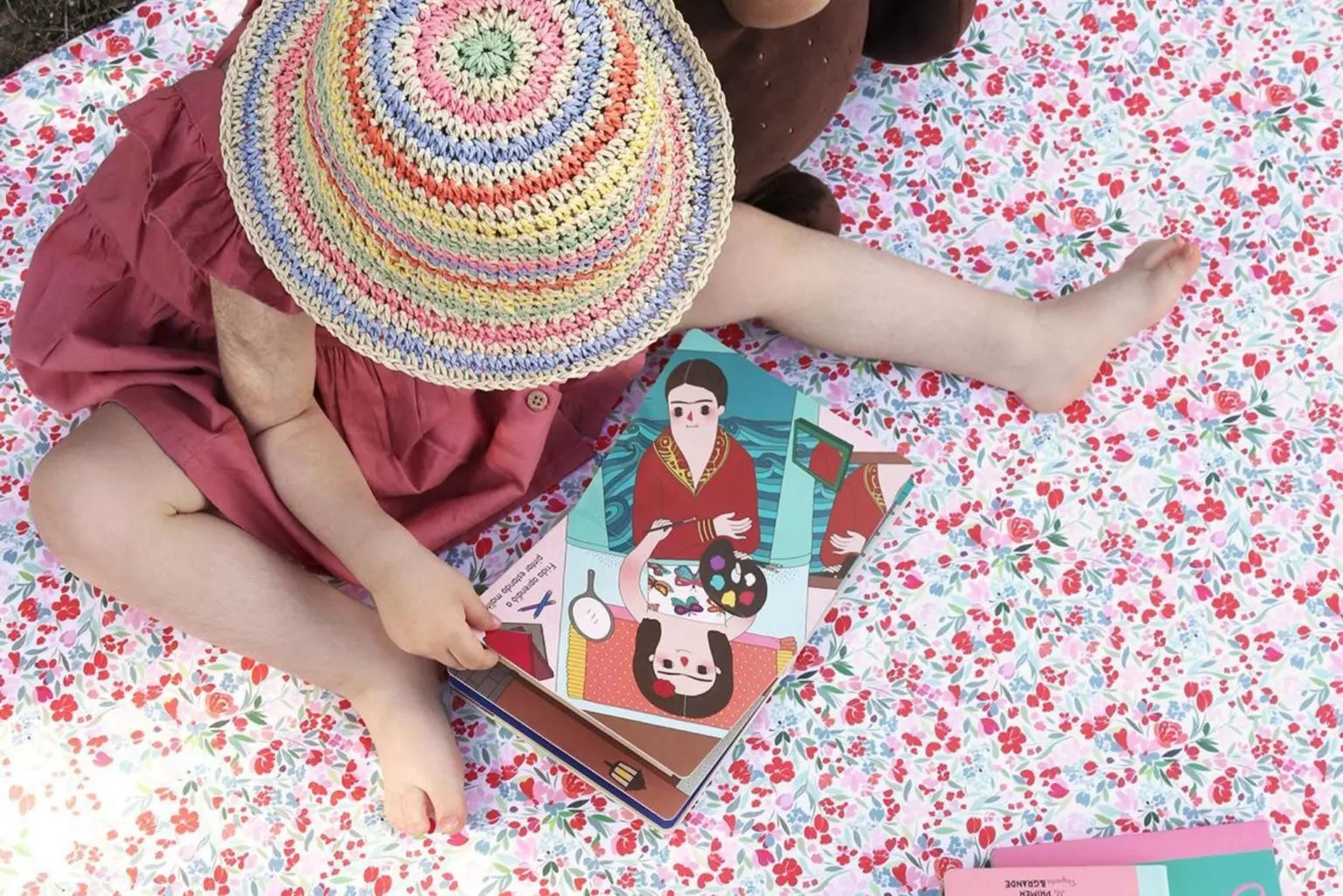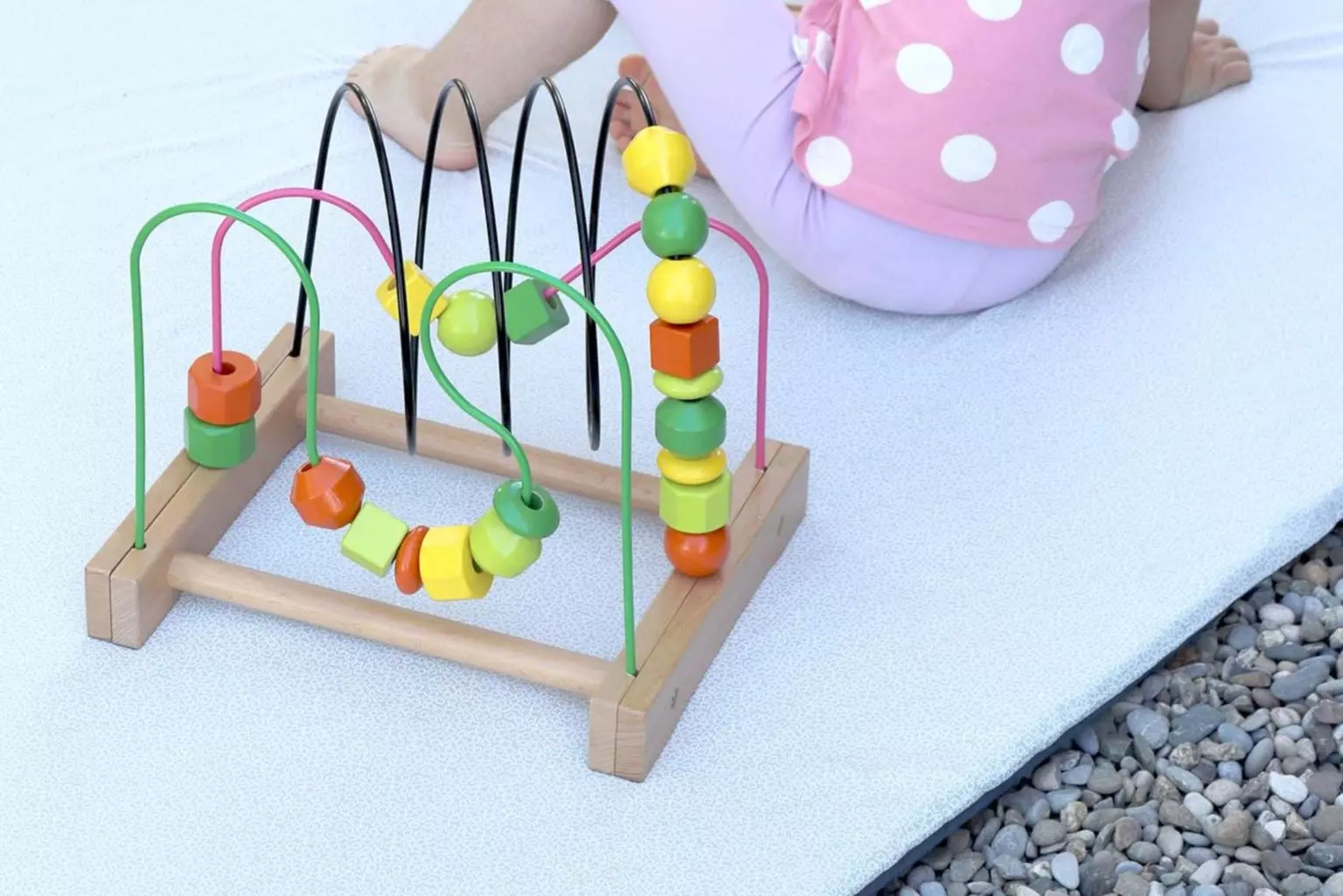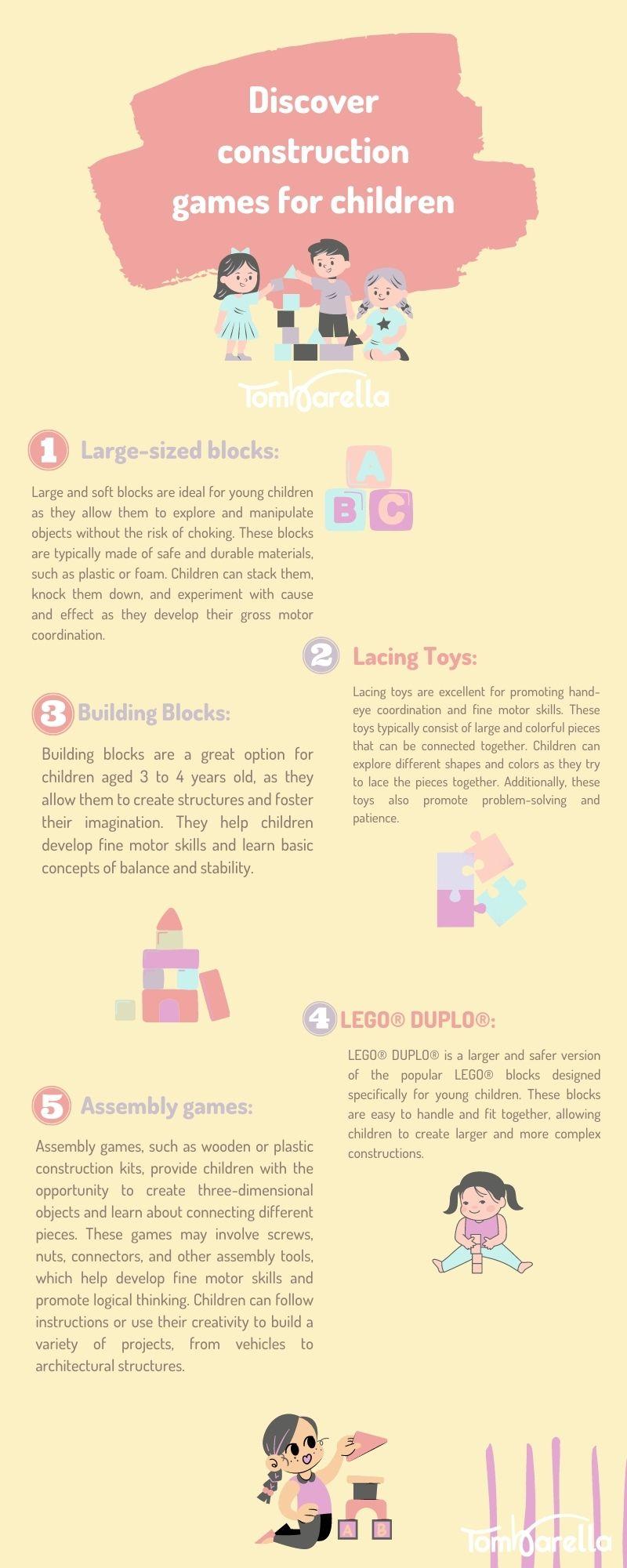Construction games for children: Fostering growth and learning
Construction games play a fundamental role in the growth and learning of children. These playful activities not only provide fun but also offer a range of key benefits for their development.
Firstly, construction play stimulates children’s creativity. It provides them with the opportunity to imagine and create their own structures, fostering individual expression and original thinking. As they experiment with different pieces and combinations, they develop divergent thinking skills and learn to see endless possibilities in each construction.
Moreover, construction games promote problem-solving. As children encounter challenges and obstacles during construction, they learn to find solutions, think critically, and persevere in the search for answers. This experience strengthens their ability to effectively tackle problems, both in play and in everyday life.
Lastly, construction games also contribute to the development of motor skills. Children manipulate pieces, fit them together, and stack them, improving their hand-eye coordination, fine motor skills, and motor control. Additionally, they learn to plan and organize their movements to achieve a stable structure, which develops their spatial awareness and ability to visualize objects in three dimensions.
Benefits of construction play in child development
Construction play offers a wide range of benefits for children’s cognitive, physical, and socio-emotional development.
Let’s explore these benefits in detail and how they positively influence their growth:
Cognitive stimulation: Construction play exercises logical thinking, planning, and problem-solving. By manipulating pieces and creating structures, children have to think about ways to fit them correctly, which develops their ability to visualize and understand spatial concepts. Additionally, construction play promotes mathematical reasoning, classification, and sequencing, preparing children for learning mathematics and other academic disciplines.
Promotion of creativity: Construction play sparks imagination and stimulates creativity. Children have the freedom to create their own designs and explore different possibilities. As they experiment with different combinations and solutions, they learn to think innovatively and find unique ways to approach challenges. This not only nourishes their creativity but also teaches them to seek alternatives and not be afraid to try new things.
Development of motor skills: Construction play enhances children’s fine and gross motor skills. By manipulating and fitting pieces together, they exercise their manual dexterity and hand-eye coordination. Additionally, building structures requires precise and controlled movements, which strengthen their fine and gross motor coordination. These motor skills developed through construction play are crucial for everyday tasks such as writing, dressing, and manipulating objects with dexterity.
Fostering concentration and attention: Construction play requires concentration and sustained attention. Children need to focus on the construction process, follow instructions, and stay engaged with the task. This focused attention helps develop concentration and persistence skills, preparing children to tackle challenges and stay focused on other academic and daily life activities.
Strengthening socio-emotional skills: Construction play encourages teamwork, communication, and cooperative learning. Children can build together, share ideas, and collaborate to achieve a common structure. This promotes social skills such as respect, active listening, negotiation, and conflict resolution. Additionally, construction play can also be a source of satisfaction and personal pride, boosting self-esteem and self-confidence.

Construction games for children aged 1 to 2 years old
During the development stage of 1 to 2 years old, construction games play a fundamental role in the growth and learning of children.
When choosing construction games for this age, it is important to consider safety and sensory stimulation. Here are some recommended options:
Large-sized blocks: Large, soft blocks are ideal for young children as they allow them to explore and manipulate objects without the risk of choking. These blocks are typically made of safe and durable materials such as plastic or foam. Children can stack them, knock them down, and experiment with cause and effect while developing their gross motor coordination.
Shape-sorting toys: Shape-sorting toys are excellent for promoting hand-eye coordination and fine motor skills. These toys usually consist of large, colorful pieces that fit together. Children can explore different shapes and colors while attempting to fit the pieces correctly. Additionally, these toys also encourage problem-solving and patience.
It’s important to remember that at this age, construction will be simple, and children’s attention span will be limited. Therefore, it is recommended to provide them with construction games that are safe, easy to manipulate, and sensory stimulating. These games will not only provide fun but also contribute to the physical and cognitive development of children.
Construction games for children aged 3 to 4 years old
In the development phase of 3 to 4 years old, construction games acquire greater complexity and offer an exciting opportunity for learning and skill development. Here are some recommended construction games for this age:
Building blocks: Building blocks are a suitable choice for children aged 3 to 4 years as they allow them to create structures and foster their imagination. It helps children develop fine motor skills and learn basic concepts of balance and stability.
LEGO® DUPLO®: LEGO® DUPLO® is a larger and safer version of the popular LEGO® blocks specifically designed for young children. These blocks are easy to manipulate and fit together, allowing children to create larger and more complex constructions. LEGO® DUPLO® stimulates hand-eye coordination, problem-solving, and creativity as children build houses, vehicles, and other structures.
In addition to these construction games, there is a wide variety of other construction toys available on the market. These toys include building systems with smaller pieces, such as 3D puzzles or themed construction sets.
These games promote concentration, planning, and imagination while developing children’s fine motor skills and hand-eye coordination.
Construction games for children aged 4 to 6 years old
In the developmental stage of 4 to 6 years old, construction games take on an even higher level of complexity, providing children with the opportunity to tackle exciting construction challenges. Here are some recommended construction games for this age:
LEGO®: LEGO® construction games are widely recognized for their versatility and ability to stimulate creativity and logical thinking. LEGO® games for this age range often include smaller, more detailed pieces that allow children to build more elaborate and sophisticated structures. Children can follow step-by-step instructions to create specific models or unleash their imagination and build their own unique creations. LEGO® games foster cognitive development, planning, problem-solving, and spatial thinking.
Assembly games: Assembly games, such as wooden or plastic construction kits, provide children with the opportunity to create three-dimensional objects and learn about connecting different pieces. These games may involve screws, nuts, connectors, and other assembly tools, helping to develop fine motor skills and promote logical thinking. Children can follow instructions or use their creativity to build a variety of projects, from vehicles to architectural structures.
Selection of construction games suitable for children
When it comes to choosing construction games for children, it’s important to consider their age, interests, and individual needs. Here are some recommendations to help you make the best decision:
Age: Check the age recommendation provided by the manufacturer of the construction game. Each game is designed to meet the specific motor and cognitive skills and abilities of a particular developmental stage. Make sure to select games that are appropriate for the child’s age, as this will ensure they are both safe and challenging.
Interests and needs: Observe the child’s particular interests. Some children may be more interested in building vehicles and machines, while others may prefer architectural structures or more imaginative creations. Take their preferences into account and choose construction games that align with their interests, as this will increase their motivation and engagement with the game.
Quality and safety: Ensure you select construction games of good quality and that meet safety standards. Check that the pieces are well-made, without sharp edges or small parts that could pose a choking hazard. The materials used should be durable and safe for children’s use. Additionally, look for safety certifications on the products and read reviews from other users to ensure you are purchasing a reliable game.
Educational value: Consider the educational value of the construction game. The best construction games not only provide entertainment but also foster the development of cognitive, motor, and creative skills. Look for games that promote problem-solving, logical thinking, hand-eye coordination, and imagination. Games that offer multiple building possibilities and allow children to experiment and explore are especially beneficial for their development.
When selecting suitable construction games for children, keep these aspects in mind and take the time to research and read reviews from other users. Remember that each child is unique, so it’s important to choose games that suit their individual interests and needs. Well-selected construction games will not only provide fun but also foster learning and holistic growth in children.
Promoting Fun and Learning with Construction Games
Here are some suggestions to engage children in creative and educational activities with construction games:
Promote imaginative play: Encourage children to use their imagination and creativity when playing with construction games. Instead of simply following instructions or building pre-set models, encourage them to create their own structures and scenarios. Encourage them to invent stories and bring their constructions to life, which will help develop their storytelling skills and exercise their imagination.
Stimulate problem-solving: Construction games present challenges that require solutions. Encourage children to face constructive problems and seek solutions. They can try building a tall and stable tower or finding a way to connect pieces of different sizes. By facing these challenges, children will develop problem-solving skills, critical thinking, and perseverance.
Foster collaboration: Construction games can also be a collaborative activity. Encourage children to work together on a construction project, sharing ideas and resources. This will help them develop social, communication, and teamwork skills. Additionally, collaboration promotes the exchange of knowledge and the joint construction of ideas, enriching the gaming experience.
Set challenges and goals: Propose specific challenges to children while playing with construction games. You could ask them to build a house with a limited number of pieces or design a vehicle that can move without falling. Setting goals ignites their ingenuity and provides a clear purpose, boosting their motivation and planning skills.
Celebrate achievements: Recognize and celebrate children’s achievements in their constructions. Value their creativity, ingenuity, and effort in the construction game. This gives them a sense of accomplishment and reinforces their self-esteem, encouraging them to continue exploring and learning through play.
Remember that the key to fostering fun and learning with construction games is to provide a supportive environment, encourage creativity, and allow children to explore and experiment. Through imaginative play, problem-solving, and collaboration, children will enjoy an enriching experience that strengthens their cognitive, emotional, and social development.

In conclusion, construction games are much more than simple fun games for children. They are educational tools that allow them to learn while they entertain themselves. By choosing appropriate, safe, and high-quality construction games, we can stimulate their imagination, develop cognitive and motor skills, and foster problem-solving and collaboration. These activities enable them to explore their creativity, overcome challenges, and lay the foundation for holistic growth. Construction games are a fun and effective way to learn while playing.

